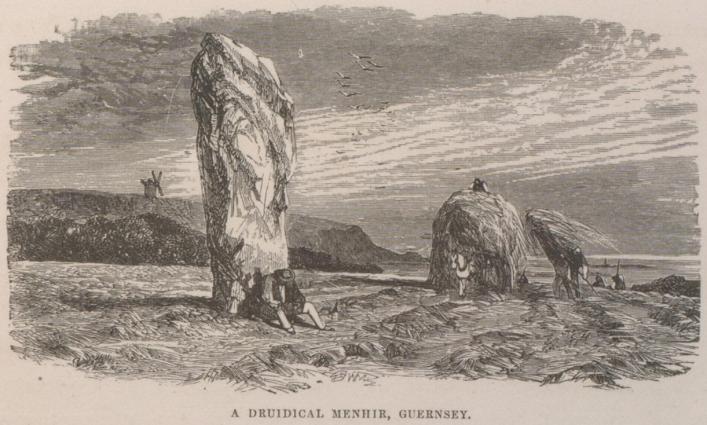Les Paysans and Le Lorier

From Report and Transactions of the Societe Guernesiaise 1892; Report of the Archaeological Section, by J James Carey.
'It was getting late in the season when I first met the Society of Natural Science in their excursion trips, so that I can only describe what came under our notice for the three or four days I was with the members. Everyone knows that high stone situated in a field just off the road from L'Erée to St Peter's, on the west side. It is called on the maps 'Longue Roque,'¹ [also known as 'La Longue Pierre' and 'La Palette ès fées,' or 'Fairies' bat'] close to the farm called Les Paysans [McCormack 323], now occupied by Mr Le Mesurier. He kindly allowed me to excavate underneath this stone. The old legend accounts for its being there that a fairy had in the quiet of the night brought it in her silk apron, and placed it in its upright position; further, the general belief in Guernsey was that the stone was as deep in the ground as what it shows above. I was determined to find this out, so, accompanied by Mr Nesfield, we commenced on the north-east side; digging down 2 feet 6 inches though yellowish soil we came to gravel. In this gravel we found a long oval round water-worn stone weighing about 2½ lb., and about 18 inches from the surface came on a stone which appeared to us like a support to the large stone. At 3 feet 2 inches below the surface, we came to the bottom of the stone, bedded in yellow clay. Thus the total length of the stone in 11 feet 6 inches out of the ground and 3 feet 2 inches below the surface, 14 feet 2 inches in all. The average circumference is about 11 feet; so the weight of this huge stone is about 8 tons. There are decided water-worn markings on the south side of this Longue Rocque and also on top.
In the Paysans Farm is a small trough supposed at one time to have been used to hold holy water, hollowed out of a beach stone. I know many of these little troughs lying about at different farm houses in this parish. There is also a niche in the hall, similar to those at the King's Mills, in three or four houses there. This may have been intended to hold figures of saints.
We then passed on to an old farm called 'Lorier,' in St Saviour's parish [McCormack 393], belonging to the Torode family. The date given is 1687, printed in small pebbles stuck in plaster over a window in an upper room, with the letters MOYNT, believed to be that Nicolas Torode built the house. In the same room is a handsome only fireplace in well-carved stones; over the fireplace are the words, 'La paix de Dieu soit ici,' 'the peace of God be here.' This is about the finest old fireplace I have seen in this island. Some have carved heads and are very quaint; the workmanship is rough, but there is a refinement about this. In the same room is a bedstead or cupboard, the first of its kind I have seen in Guernsey. How the people of old could have passed eight or ten hours in such a miserable box, 6 by 6 by 5, when the curtains were closed, sunk down in feather beds and feather pillows in a small stuffy room, is beyond belief.'²
In this report James Carey also talks about his excavations on Lihou island and the Robilliard house, 'Les Clercs', in St Peter's, St Brioc, St Appoline, Vazon and the Grande Mare.
27.11.1958. General Oliver de Lancey Williams notes in Guernsey granite fireplaces: 'This farm has been entirely renovated and the fireplace has been removed. It is now called 'Westward Ho.' The fireplace is at Mr Le Couteur's yard at L'Erée. He did the rebuilding of the house.' Le Couteur took the fireplace in part payment of the building costs.
¹ See also, 'La Palette des fées,' by T F Priaulx, in Quarterly Review of the Guernsey Society 1964, and by the same author, 'Le Messurier houses in the western parishes,' Rep. & Trans. Soc. Guernesiaise, 1951, p. 146. The Palette was also the site of the burning of a 'guy' on November 5th: Edith Carey, in her Report to the Folklore Section in the Rep. & Trans of the Société Guernesiaise, 1922, says, 'The Rev. J A F Ozanne reports to me that, up to the other day when, as you know, the ceremony was abolished, the parishioners of St Pierre du Bois and St Saviour's burned their 'Guy Fawkes' at the foot of the menhir at Les Paysans. There they danced round the flames of the funeral pyre [..].'. Lieut-Col T W M de Guérin, in his 'List of dolmens, menhirs &c' in the Transactions of La Société Guernesiaise, Vol. IX, 1921-5, p. 45: 'This is the largest existing menhir in Guernsey. [...] It is first mentioned in Lettres [under seal] of 20 April 1487' when Nicolas de Lisle, son of Olivier, of St Pierre-du-Bois, sells a strip of land to the east of it to Pierre Le Mesurier, son of Pierre of the same parish. 'A cross stood in the road near it.'
² See Guernsey Folk Lore, p. 249, 'The dole of loaves at Le Laurier:' loaves were distributed to the poor from this house on Christmas Eve and Good Friday, the reason for which gift being associated with several traditions and legends of the supernatural, including being haunted by a giant black sow and her litter of ravenous piglets [Bois, Jersey Superstitions &c I, p, 397.]
